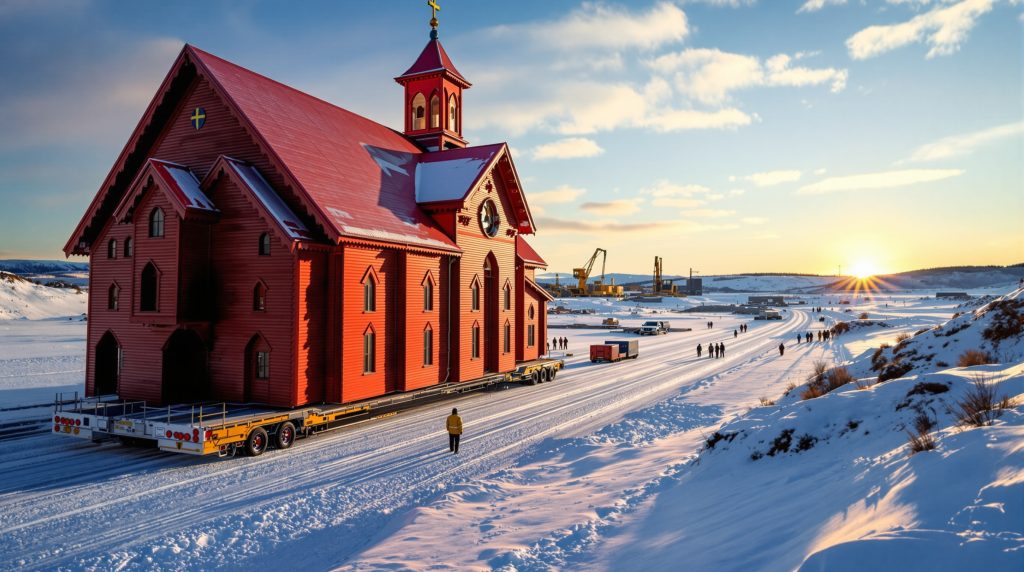Historic Wooden Church Relocation in Kiruna: A Testament to Cultural Preservation
In northern Sweden, a remarkable engineering feat is underway as one of the country's most treasured wooden structures embarks on an extraordinary journey. The historic Kiruna church, a beloved 113-year-old landmark, is being transported to a new location in what represents both a technical marvel and a powerful symbol of community resilience in the face of industrial necessity.
The Threat of Mining Subsidence
The city of Kiruna sits atop what has become known as the world's largest underground iron ore mine. This massive industrial operation, while economically vital for the region, has created a serious problem: ground subsidence. As mining operations have expanded over decades, the very earth beneath Kiruna has begun to sink and shift, threatening the structural integrity of buildings throughout the city.
For the iconic wooden church relocation in Kiruna, this subsidence presents an existential threat. The 600-ton structure, built in the early 20th century, faces potential damage or destruction if left in its original location. Rather than lose this architectural treasure, authorities have undertaken the ambitious task of relocating it entirely.
This church relocation is part of a comprehensive 30-year urban transformation project that involves moving numerous buildings and relocating thousands of residents away from the unstable ground. The scale of this endeavor is unprecedented in modern European urban planning.
LKAB's Mining Impact on Kiruna
The state-owned mining company LKAB operates the iron ore operations that have necessitated this massive relocation project. Since beginning operations in the 1890s, LKAB has extracted approximately 2 billion tonnes of iron ore from the Kiruna region, fundamentally transforming both the landscape and the community.
The mining company's extensive operations have been both a blessing and challenge for the region. While providing economic opportunity and employment, the physical impact on the land has created the current crisis requiring the church's relocation.
Geological surveys indicate that mineral resources in the greater Kiruna region remain substantial, with an estimated 6 billion additional tonnes of ore deposits across Kiruna, Svappavaara, and Malmberget. This abundance ensures iron ore trends will continue to impact the region for generations, but also means the city must adapt to the geological realities created by this industrial activity.
Engineering the Church's Journey
The technical aspects of moving a 600-ton wooden church are nothing short of remarkable. Workers have employed specialized hydraulic jacking equipment to carefully lift the entire structure from its foundations, a process requiring meticulous planning and execution to prevent any damage to the historic building.
Once lifted, the church was placed onto a custom-built trailer specifically designed to distribute the massive weight evenly during transport. This specialized equipment allows the structure to remain level and stable throughout its journey despite its enormous size and delicate construction.
LKAB has invested significant resources in preparing for this monumental move. Over the past year, roads along the planned route have been widened to accommodate the church's substantial dimensions. Infrastructure modifications included removing potential obstacles, reinforcing roadbeds, and ensuring all bridges and culverts could support the combined weight of the church and transport equipment.
The Planned Route and Timeline
The wooden church's journey spans approximately 5 kilometers (3 miles) along a carefully mapped route from its original location to Kiruna's new city center. While this distance might seem modest, the delicate nature of the cargo requires extraordinary caution.
The entire transport operation is scheduled to take two full days to complete, moving at a deliberately slow pace to minimize vibration and stress on the historic structure. Engineers monitor the building constantly throughout the move, checking for any signs of structural strain.
This methodical approach is essential for preserving one of Sweden's largest and most culturally significant wooden buildings. The slow-moving procession has also become something of a public spectacle, with residents gathering to witness this historic Swedish church being transported to its new home.
The Cultural Significance of Kiruna Church
The striking red-painted church isn't just an impressive architectural achievement; it represents the cultural and spiritual heart of Kiruna. Often voted Sweden's most beautiful church, the 113-year-old structure exemplifies early 20th century Swedish ecclesiastical design and craftsmanship.
Built during a time when Kiruna was expanding as a mining community, the church served as both a religious center and a symbol of permanence and civilization in Sweden's far north. Its distinctive silhouette against the Arctic landscape has become emblematic of the region itself.
The church's architectural significance extends beyond its aesthetic appeal. As one of Sweden's largest wooden structures, it represents an important example of timber construction techniques and traditional Swedish building methods that have been passed down through generations of craftspeople.
Community Sentiment About the Relocation
For Kiruna's residents, the wooden church relocation in Kiruna evokes complex emotions. Local vicar Lena Tjarnberg captured this sentiment perfectly when she described the church as "Kiruna's soul" and "a safe place" for the community.
"The church is Kiruna's soul in some way, and in some way it's a safe place," Tjarnberg explained. "For me, it's like a day of joy. But I think people also feel sad because we have to leave this place."
This mixture of optimism and nostalgia characterizes much of the community's response to the relocation. While residents recognize the necessity of moving the beloved structure to preserve it, there remains an undeniable sadness at seeing it leave the place where it has stood for over a century.
The church's journey has become a powerful metaphor for the community itself—uprooted from its historical foundations but moving forward with determination to preserve what matters most.
Impact on Indigenous Sami Communities
Beyond the physical relocation of buildings, Kiruna's transformation raises profound questions about land use and indigenous rights. The Kiruna region is traditional Sami territory, used for reindeer herding for thousands of years before mining operations began.
Lars-Marcus Kuhmunen, chair of the local Gabna Sami community, provides important historical context: "This area is traditional Sami land. This area was grazing land and also a land where the calves of the reindeer were born."
The expansion of mining activities has progressively encroached on lands vital to traditional Sami practices. The reindeer herding that forms the backbone of Sami cultural identity requires vast tracts of undisturbed land for seasonal migrations and grazing.
Historical Perspective and Future Concerns
The current challenges facing the Sami community aren't unexpected. Kuhmunen references his great-grandfather's prediction from 50 years ago that "the mine is going to eat up our way of life, our reindeer herding." This intergenerational perspective illustrates how industrial development has gradually transformed indigenous lifeways over decades.
Looking toward the future, Kuhmunen and other Sami leaders express grave concerns about additional proposed mining operations. These developments could potentially sever crucial migration corridors "from the reindeer's summer and winter pastures," making traditional herding practices virtually impossible to maintain.
While the wooden church relocation in Kiruna has captured public attention, it represents just one aspect of a much broader transformation affecting indigenous land use patterns that have existed for millennia. The challenge of balancing economic development with the preservation of indigenous cultural practices remains largely unresolved.
The Scale of Kiruna's City Transformation
The church relocation, while impressive, is merely one component of a massive urban transformation project. Approximately 3,000 homes housing around 6,000 residents must be relocated due to ground instability caused by mining operations.
This population shift represents one of the most ambitious planned urban relocations in modern European history. The logistics of moving an entire city center while maintaining community cohesion and providing continuous services has required unprecedented planning and coordination.
Buildings throughout Kiruna are being handled in various ways depending on their historical significance, structural condition, and practical considerations. Some structures are being demolished entirely, while others are moved intact. In some cases, historically important buildings are being carefully dismantled and rebuilt in the new city center, preserving their cultural value while adapting to the new urban layout.
New Development and Infrastructure
The creation of Kiruna's new urban core has involved constructing hundreds of new homes, commercial spaces, and essential public buildings. A new city hall serves as an architectural focal point for the relocated community, providing continuity in municipal governance during this period of dramatic change.
Mayor Mats Taaveniku describes the project as "half on the way" with approximately 10 years of work remaining before completion. This timeline reflects the enormous complexity of relocating not just physical structures but the entire social fabric of a community.
The new city center has been designed with modern urban planning principles in mind, incorporating mining sustainability insights and pedestrian-friendly layouts that weren't possible in the original century-old urban core. In this sense, the relocation represents not just a preservation effort but an opportunity to reimagine what Kiruna can become for future generations.
Mining Expansion's Economic Benefits for Sweden
The extensive disruption caused by Kiruna's relocation must be understood within the broader economic context of Sweden's mining industry. LKAB produces approximately 80% of all iron ore mined in Europe, making it a crucial component of the continent's industrial supply chain.
This economic importance extends far beyond Sweden's borders. The company's operations represent a strategic asset for European manufacturing and construction sectors that depend on reliable access to high-quality iron ore.
The mine expansion that necessitated Kiruna's wooden church relocation in Kiruna will ensure these operations can continue for decades to come, securing both local employment and Sweden's position as a key mineral producer. This long-term economic stability helps justify the substantial investment required for relocating the church and other aspects of the city.
Strategic Rare Earth Elements
Beyond traditional iron ore mining, the Kiruna region holds another resource of increasing global importance: rare earth elements. The proposed Per Geijer mine adjacent to the existing Kiruna site contains significant deposits of these 17 critical metals, essential for technologies ranging from lasers to smartphones and renewable energy systems.
The European Union designated Per Geijer as a Strategic Project in March 2025, potentially accelerating its development as part of Europe's broader strategy to secure critical minerals & energy. This designation reflects growing recognition that rare earth elements are essential to modern technological and industrial capabilities.
These deposits are particularly significant given current supply chain vulnerabilities. As green technologies become increasingly important for meeting climate goals, securing reliable access to the materials needed for their production has become a strategic priority for many nations.
Reducing Dependency on China
Europe currently relies almost exclusively on China for both the supply and processing of rare earth elements. This dependency creates potential vulnerabilities in critical supply chains and limits Europe's technological sovereignty.
The development of Per Geijer and similar European mining projects could help diversify global supply networks for these essential minerals. By establishing domestic sources of rare earth elements, Europe can reduce geopolitical risks while supporting its own manufacturing sectors.
This strategic dimension adds another layer of complexity to Kiruna's transformation. The economic benefits extend beyond local employment to include national security and industrial policy considerations that affect Sweden's position within the broader European economy.
Lessons From Kiruna's Church Relocation
The monumental effort to relocate Kiruna's wooden church offers valuable insights into how communities can balance heritage preservation with economic development. Rather than allowing a historically significant structure to be sacrificed to industrial necessity, Swedish authorities have invested in an engineering solution that preserves cultural heritage while allowing vital economic activity to continue.
This approach, while expensive and technically challenging, demonstrates a commitment to maintaining cultural continuity even during periods of dramatic change. The 30-year relocation project represents one of the most ambitious urban transformations in modern European history, offering potential lessons for other communities facing similar challenges.
The careful planning and execution required for this project highlight the importance of long-term thinking when managing conflicts between heritage preservation and economic development. By taking a decades-long view rather than seeking quick solutions, Kiruna has created a framework that addresses multiple competing interests.
Symbolic Significance of the Church Move
Mayor Taaveniku aptly describes the church as "a statement or a symbol for this city transformation." The physical journey of this beloved structure embodies the community's transition to a new location and a new phase of its history.
The preservation effort highlights the value placed on cultural heritage despite significant economic pressures. Rather than allowing mining profits to dictate all decisions, the community has insisted on maintaining connections to its past while adapting to new realities.
This balance between preservation and adaptation may offer the most important lesson from Kiruna's experience. By refusing to see heritage preservation and economic development as mutually exclusive goals, the community has created a model that might inspire similar mining transformation trends and mining industry evolution elsewhere.
FAQs About Kiruna's Church Relocation
When was Kiruna Church originally built?
The church was constructed approximately 113 years ago (around 1912), making it an early 20th-century structure that has stood at its original location for over a century before the current relocation.
How much does the wooden church weigh?
The wooden church structure weighs approximately 600 tons, requiring specialized lifting equipment and a custom-built trailer for transportation.
How far is the church being moved?
The church is being relocated approximately 5 kilometers (3 miles) from its original location to Kiruna's new city center.
How long will the church relocation take?
The physical movement of the church is scheduled to take two days to complete, though preparations for the move have been underway for much longer.
Why can't the church remain in its original location?
Ground subsidence caused by the underground iron ore mining operations has made the original location unstable and unsafe for the historic structure.
How many people are being relocated in Kiruna?
Approximately 6,000 people living in around 3,000 homes need to be relocated as part of the broader city transformation project.
When will Kiruna's city transformation be complete?
According to the mayor, the project is approximately halfway complete with about 10 more years of work remaining before the entire relocation is finished.
Disclaimer: This article presents information about ongoing mining operations and their impacts on communities and environments. While every effort has been made to ensure accuracy, future developments may differ from projections mentioned. This content should not be considered financial or investment advice. Readers interested in investment opportunities related to mining operations should consult qualified financial advisors.
Want to Discover the Next Major Mining Opportunity?
Discovery Alert's proprietary Discovery IQ model delivers real-time notifications on significant ASX mineral discoveries, transforming complex data into actionable investment insights. Explore how these discoveries can generate substantial returns by visiting the dedicated discoveries page and position yourself ahead of the market.




